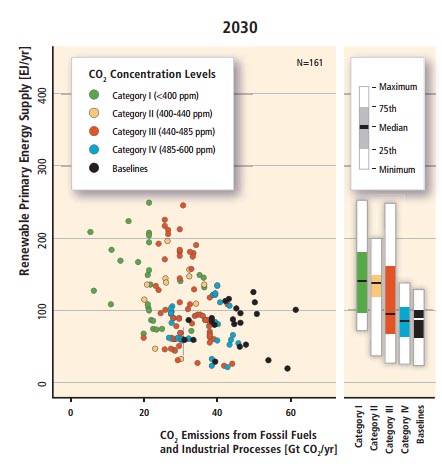Climate Change: Connecting the Dots
Climate Change: Connecting the Dots

Sometimes pictures tell the story best.

Last year the Intergovernmental Panel on Climate Change complied and published the results of several studies on renewable energy. The good news is that there is tremendous potential for the use of renewable forms of energy. But I am struck by two charts in the Summary for Policymakers.
These charts project various scenarios for the portion of the total energy supply provided by renewable energy on the vertical axis and total CO2 emission on the horizontal axis, with color coded dots that indicate projected atmospheric concentrations of CO2. The green dots represent concentrations of less than 400 parts per million (ppm), the yellow 400-440 pmm. There are multiple dots because the charts compile several projections of the future.

The charts confirm what most of us would expect. To achieve lower CO2 concentrations, increased reliance on renewable energy is needed and total CO2 emissions must drop precipitously. Green dots, and to a lesser extent yellow dots as well, predominate in the northwest corner of the chart.
Currently, atmospheric concentrations of CO2 are around 394 ppm. And in 2011 total CO2 emissions were around 31.6 gigatonnes. It gives one pause to observe that, according to several projections in the first chart, in eighteen years total emissions must be no more than two-thirds of current emissions (according to some projections much less) to be on track eventually to stabilize atmospheric concentration levels below 400 ppm. And by 2050 the green dots are approaching zero. Note this allows for higher concentrations than the activists at 350.org would like. But the 350–400 ppm range (green dots) is what the IPCC Fourth Assessment Report projected was necessary to stabilize the global average temperature at 2–2.4° above pre-industrial levels. Two degrees was the goal decided upon at the Cancun United Nations Framework Convention on Climate Change (UNFCCC) meeting in 2010. The 400–440 ppm range (yellow dots) would make for a likely a temperature increase of 2.4–2.8°.
One story this picture tells is that hitting the two degrees goal requires a dramatic transformation of energy production across the globe in the next eighteen years. Are we politically, dare I say morally, capable of such a transformation? It’s an open question.
The UNFCCC, of which the United States is a signatory, calls on developed countries “to take the lead in combating climate change.” Obviously, it would require considerable leadership to produce an international commitment sufficient to steer energy production and consumption so sharply toward the use of renewables. Leadership of that sort requires, among other things, credibility, good will, and sufficient control over outcomes to produce a difference.
As the second biggest CO2 emitter globally, the United States certainly has sufficient control to have an impact on global emissions. But it lacks the requisite credibility. The U.S. pledge at the Copenhagen meeting of the UNFCCC was to reduce emissions by 2020 to 17 percent below 2005 levels. Compare that to the EU’s pledge to reduce emissions 20 percent below 1990 levels, and by 30 percent if other developed countries make similar commitments and if developing countries make commitments appropriate to their capabilities. The U.S. reduction pledge translated into a common currency of 1990 levels is a miserly 3.75 percent.
This summer the minister of the environment of the conservative (Christian Democratic) German government unveiled an energy plan that includes a unilateral German commitment to a 30 percent emissions reduction. This follows on the heels of the announcement last year that all German nuclear power plants are to be closed by 2020. The so-called Energiewende is meant to modernize the German economy along environmentally friendly lines. The opposition Social Democrats have criticized the plan as being short on details. But apparently there is no lack of commitment to the Energiewende in principle.
It would take considerable powers of imagination to conceive of conservatives in the United States proposing policies that would fundamentally transform the economy away from fossil fuels. Unlike their German counterparts, American conservatives would rather entertain doubts about the reliability of the mainstream science behind the IPCC charts. It is usually easier to be irresponsible than to lead. The U.S. Left can only dream of being able to criticize the Right for its empty rhetorical commitment to doing something significant about climate change.
As a result of the Durban meeting of the UNCCC last year, the signatories are committed to forging a comprehensive climate change protocol by 2015, one that will take effect in 2020. There is no reason to think that the United States is going to connect the dots in time to lead on climate change. The more important practical question for that process is how to push it along given the evident incapacity of the United States not only to lead, but to make any significant commitments regarding climate change.






